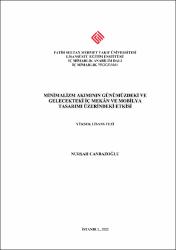| dc.contributor.advisor | Yıldız, Mualla | |
| dc.contributor.author | Canbazoğlu, Nurşah | |
| dc.date.accessioned | 2023-02-17T13:28:07Z | |
| dc.date.available | 2023-02-17T13:28:07Z | |
| dc.date.issued | 2022 | en_US |
| dc.identifier.citation | CANBAZOĞLU, Nurşah, Minimalizm akımının günümüzdeki ve gelecekteki iç mekân ve mobilya tasarımı üzerindeki etkisi, Fatih Sultan Mehmet Vakıf Üniversitesi Lisansüstü Eğitim Enstitüsü İç Mimarlık Anabilim Dalı İç Mimarlık Programı,Yayımlanmamış Yüksek Lisans Tezi, İstanbul 2022 | en_US |
| dc.identifier.uri | https://hdl.handle.net/11352/4280 | |
| dc.description.abstract | Çalışmada Minimalizm’in iç mekan tasarımındaki yansımaları farklı başlıklar altında ele alınmıştır. Bir akımdan ziyade yaklaşım biçimi olarak ele almanın daha doğru olacağı Minimalizm’in tanım çerçevesini genişleterek birbirinden farklı dönem ve düşünce sistemlerindeki varlığı üzerine durulmuştur. Modernizm ile daha çok bağdaştırılsa dahi Minimalizm’i var eden kavramlar, daha önceki dönemlerde de dünyanın farklı bölgelerinde kendini göstermektedir. Bu durum Minimalizm’in zaman üstü bir kavram olduğu düşüncesini netleştirmektedir.
Neredeyse tüm felsefe ve düşünce sistemlerinde erdem olarak yüceltilen “yalınlık”, “tevazu” kavramları Minimalizm ile kuvvetli bağa sahiptir. Gereksiz olandan uzaklaşıp “öz”e yaklaşma fikri, yaşanılan çevreyi yani mimari-iç mimariyi etkilemektedir. Dönemin koşulları, geçmişten gelen alışkanlıklarla şekillenen yaşam, tasarıma yön veren önemli faktörlerdendir. Bu sebeple günümüz ve geleceğin olası koşulları dikkate alındığında Minimalizm’in iç mimaride kullanımı daha işlevsel ve estetik ürünlerin ortaya çıkmasına yardımcı olacaktır.
Yapılan araştırmanın ilk bölümünde Minimalizm’in tanımına, din ve düşünce sistemlerindeki karşılığına yer verilmiştir. Sanattaki gelişmeler her dönemde mimariyi, iç mimariyi etkilediğinden bir sonraki bölümde Minimalizm’in sanattaki yeri araştırılmıştır. Sadece “Minimal Sanat” değil ona zemin hazırlayan süreç üzerine durulmuştur. Ayrıca Minimalist sanatçılar ve eserleri irdelenmiştir. Dördüncü bölüm kapsamındaysa “yalınlık”, “basitlik” gibi Minimalizm’i var eden kavramların ilk mimari örneklerden günümüze kadarki süreci ve farklı dönemlerdeki ürünlerin Minimalist özellikleri incelenmiştir. Bölümün sonunda mekanının parçası olan mobilyanın tarihinde Minimal yaklaşımlara yer verilmiştir.
Beşinci bölümde, önceki bölümlerde elde edilen bilgiler üzerinden Minimalizm’i var eden ve Minimalizm’in var ettiği bazı tasarım özellikleri sınıflandırılmıştır. Sonrasında giderek yaygınlaşan, gelecek mimari ve mekan tasarımı üzerine çalışmalarda yer edinmiş “mikro konut” tasarımlarındaki Minimalist yaklaşımlar irdelenmiştir. Sürdürülebilir, işlevsel ve yalın mekan örnekleriyle Minimalizm’in geçmişte olduğu kadar gelecekte de var olacağı olgusu üzerine durulmuştur.
Altıncı bölümde çalışma kapsamında çeşitli şekillerde yorumlanmış Minimalizm’in geçici bir akımdan ziyade gelecek iç mimarlığını şekillendirecek güçte bir kavram olduğu sonucuna varılmıştır. | en_US |
| dc.description.abstract | In the study, the reflections of Minimalism in interior design are discussed under different headings. By expanding the definition framework of Minimalism, which would be more appropriate to consider as an approach rather than a movement, its existence in different periods and thought systems was emphasized. Even if it is more associated with modernism, the concepts that brought Minimalism into existence have also appeared in different parts of the world in previous periods. This situation reinforces the idea that Minimalism is a timeless concept.
The concepts of "simplicity" and "modesty", which are glorified as virtues in almost all philosophy and thought systems, have a strong connection with Minimalism. The idea of moving away from the unnecessary and approaching the "essence" affects the living environment, namely architecture-interior architecture. The conditions of the period and the life shaped by the habits from the past are among the important factors that shape the design. For this reason, considering the possible conditions of today and the future, the use of Minimalism in interior architecture will help to create more functional and aesthetic products.
In the first part of the research, the definition of Minimalism and its equivalent in religion and thought systems are given. Since developments in art affect architecture and interior architecture in every period, the place of Minimalism in art is researched in the next section. Not only "Minimal Art" but also the process that laid the groundwork for it was emphasized. In addition, Minimalist artists and their works were examined. Within the scope of the fourth chapter, the process of concepts such as “simplicity” and “purity” that created Minimalism from the first architectural examples to the present and the Minimalist features of products from different periods were examined. At the end of the section, Minimal approaches are included in the history of furniture, which is a part of the space.
In the fifth chapter, some design features that created Minimalism and created by Minimalism are classified based on the information obtained in the previous sections. The Minimalist approach of “micro-housing”, which has become increasingly widespread afterward and has taken place in studies on future architecture and space design, has been examined. Emphasis is placed on the fact that Minimalism will exist in the future as well as in the past, with examples of sustainable, functional and plain spaces.
In the sixth chapter, it has been concluded that Minimalism, which has been interpreted in various ways within the scope of the study, is a powerful concept that will shape the future interior architecture rather than a temporary trend. | en_US |
| dc.language.iso | tur | en_US |
| dc.publisher | Fatih Sultan Mehmet Vakıf Üniversitesi, Lisansüstü Eğitim Enstitüsü | en_US |
| dc.rights | info:eu-repo/semantics/openAccess | en_US |
| dc.subject | Minimalizm | en_US |
| dc.subject | Minimalist Yaşam | en_US |
| dc.subject | Minimalist Mekan | en_US |
| dc.subject | Minimalist Mobilya | en_US |
| dc.subject | Mikro Konut | en_US |
| dc.subject | Tadao Ando | en_US |
| dc.subject | Minimalism | en_US |
| dc.subject | Minimalist Life | en_US |
| dc.subject | Minimalist Interior Design | en_US |
| dc.subject | Minimalist Furniture | en_US |
| dc.subject | Micro Housing | en_US |
| dc.title | Minimalizm akımının günümüzdeki ve gelecekteki iç mekân ve mobilya tasarımı üzerindeki etkisi | en_US |
| dc.type | masterThesis | en_US |
| dc.contributor.department | FSM Vakıf Üniversitesi, Lisansüstü Eğitim Enstitüsü, İç Mimarlık Ana Bilim Dalı | en_US |
| dc.relation.publicationcategory | Tez | en_US |
| dc.contributor.institutionauthor | Canbazoğlu, Nurşah | |



















